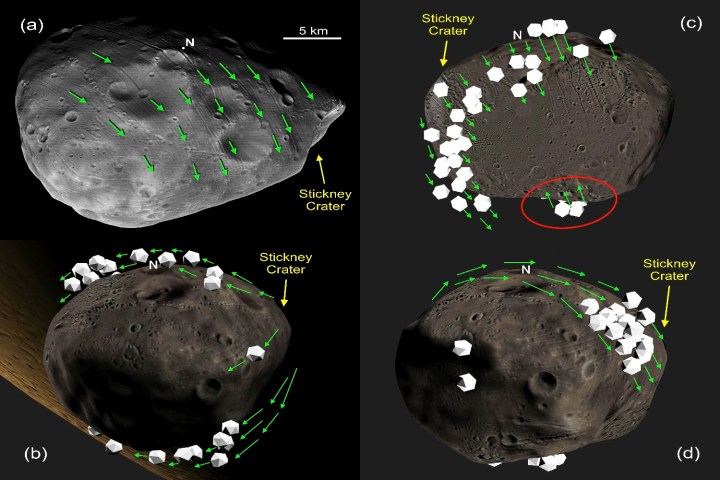
Like a space-age version of how the leopard got its spots or how the camel got its hump, the question of how the Martian moon Phobos got the strange groove patterns crisscrossing its surface has captured imaginations for years. While other moons and planets have grooves on their surface, none are quite so completely covered as Phobos. Over the past decades, planetary scientists have posed many suggestions to explain this phenomenon, without any specific conclusions being reached. Perhaps until now, that is.
Using advanced computer modeling techniques, scientists from Brown University believe they’ve come up with an answer: rolling boulders, which were the result of an asteroid impact 150 million years ago, causing the moon’s giant Stickney Crater in the process.
“To assess the rolling boulder idea, we built a computer model that simultaneously takes a witches brew of forces into account,” Ken Ramsley, a planetary science researcher at Brown, told Digital Trends. “We include the weight of the boulders, their starting velocities and directions, the gravity of Phobos and Mars, the rotation of Phobos that was sped up by the same forces that produced Stickney Crater, and the orbit of Phobos. We also include the friction of boulders while they are rolling, and when we toss nearly 100 boulders into the model, sit back, and watch what happens.”
The model directly answers four of the major objections to the rolling boulder theory, namely that the grooves do not radiate from Stickney Crater, grooves that crosscut other grooves, grooves that are observed inside Stickney, and the absence of groove across a large region of Phobos.
The results of the simulation were run on a high-end gaming computer. “We searched for quite a while to find a system that could handle this problem,” Ramsley continued. “Most three-dimensional software systems in planetary science focus on events that take place over thousands or millions of years.” The problem, in this case, was that Ramsley thinks the entire groove formation took place in under 12 hours, the merest blink of an eye in planetary history terms.
“For its power and flexibility, we chose Blender software with its embedded Bullet physics engine and tested it with simple models until we were certain it would correctly handle every aspect of gravity in our model,” he noted. “Where our Blender model can predict specific events that we can measure, like the length of time of a simple orbit, we are certain that the mechanics of our model are accurate — and therefore we are very confident in the results of our study.”
A paper describing the work was recently published in the journal Planetary and Space Science.


